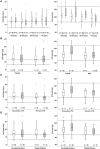Diagnostic Accuracy in Acute Venous Thromboembolism: Comparing D-Dimer, Thrombin Generation, Overall Hemostatic Potential, and Fibrin Monomers
- PMID: 32844145
- PMCID: PMC7440969
- DOI: 10.1055/s-0040-1714210
Diagnostic Accuracy in Acute Venous Thromboembolism: Comparing D-Dimer, Thrombin Generation, Overall Hemostatic Potential, and Fibrin Monomers
Abstract
Introduction For acute venous thromboembolism (VTE), a biomarker with higher specificity than D-dimer would be of great clinical use. Thrombin generation and overall hemostatic potential (OHP) reflect the hemostatic balance by globally assessing multiple coagulation factors and inhibitors. These tests discriminate between healthy controls and patients with a prothrombotic tendency but have yet to be established as clinical biomarkers of VTE. Objective This study compares endogenous thrombin potential (ETP) and OHP to D-dimer and fibrin monomers (FM) in outpatients with suspected VTE. Methods A cross-sectional diagnostic study where 954 patients with suspected pulmonary embolism or deep venous thrombosis were recruited consecutively from the medical emergency department at Karolinska University Hospital. D-dimer, FM, OHP, and ETP were analyzed in a subpopulation of 60 patients with VTE and 98 matched controls without VTE. VTE was verified either by ultrasonography or computed tomography and clinical data were collected from medical records. Results Compared with healthy controls, both VTE and non-VTE patients displayed prothrombotic profiles in OHP and ETP. D-dimer, FM, ETP area under the curve (AUC), and ETP T lag were significantly different between patients with VTE and non-VTE. The largest receiver-operating characteristic AUCs for discrimination between VTE and non-VTE, were found in D-dimer with 0.94, FM 0.77, and ETP AUC 0.65. No useful cutoff could be identified for the ETP or the OHP assay. Conclusion Compared with D-dimer, neither ETP nor OHP were clinically viable biomarkers of acute venous thrombosis. The data indicated that a large portion of the emergency patients with suspected VTE were in a prothrombotic state.
Keywords: clinical studies; deep vein thromboses; global hemostatic assays; predictive value of tests; pulmonary embolism.
Conflict of interest statement
Conflict of Interest J.P.A. reports grants and other from CSL Behring, other from NovoNordisk, during the conduct of the study. All other authors have nothing to disclose.
Figures




Similar articles
-
Biomarkers for the diagnosis of venous thromboembolism: D-dimer, thrombin generation, procoagulant phospholipid and soluble P-selectin.J Clin Pathol. 2018 Nov;71(11):1015-1022. doi: 10.1136/jclinpath-2018-205293. Epub 2018 Aug 9. J Clin Pathol. 2018. PMID: 30093507
-
Extensive evaluation of the instrumentation laboratory IL test D-Dimer immunoturbidimetric assay on the ACL 9000 determines the D-Dimer cutoff value for reliable exclusion of venous thromboembolism.Lab Hematol. 2004;10(2):88-94. doi: 10.1532/LH96.04018. Lab Hematol. 2004. PMID: 15224764
-
Performance of C-Reactive Protein, Procalcitonin, TAT Complex, and Factor VIII in Addition to D-Dimer in the Exclusion of Venous Thromboembolism in Primary Care Patients.J Appl Lab Med. 2022 Mar 2;7(2):444-455. doi: 10.1093/jalm/jfab094. J Appl Lab Med. 2022. PMID: 34597379
-
Diagnostic accuracy of biomarker D-dimer in patients after stroke suspected from venous thromboembolism: A diagnostic meta-analysis.Clin Biochem. 2019 Jan;63:126-134. doi: 10.1016/j.clinbiochem.2018.09.011. Epub 2018 Sep 24. Clin Biochem. 2019. PMID: 30261183
-
Different accuracies of rapid enzyme-linked immunosorbent, turbidimetric, and agglutination D-dimer assays for thrombosis exclusion: impact on diagnostic work-ups of outpatients with suspected deep vein thrombosis and pulmonary embolism.Semin Thromb Hemost. 2006 Oct;32(7):678-93. doi: 10.1055/s-2006-951296. Semin Thromb Hemost. 2006. PMID: 17024595 Review.
Cited by
-
Thrombin generation indices and Wells score predict pulmonary embolism in patients with acute exacerbation of chronic obstructive pulmonary disease.Clinics (Sao Paulo). 2025 Feb 27;80:100582. doi: 10.1016/j.clinsp.2025.100582. eCollection 2025. Clinics (Sao Paulo). 2025. PMID: 40022893 Free PMC article.
-
Diagnostic Blood Biomarkers for Acute Pulmonary Embolism: A Systematic Review.Diagnostics (Basel). 2023 Jul 6;13(13):2301. doi: 10.3390/diagnostics13132301. Diagnostics (Basel). 2023. PMID: 37443693 Free PMC article. Review.
References
-
- Parfrey P. The clinical epidemiology of contrast-induced nephropathy. Cardiovasc Intervent Radiol. 2005;28 02:S3–S11. - PubMed
-
- Refaai M A, Riley P, Mardovina T, Bell P D. The clinical significance of fibrin monomers. Thromb Haemost. 2018;118(11):1856–1866. - PubMed
-
- Farm M, Siddiqui A J, Onelöv L. Age-adjusted D-dimer cut-off leads to more efficient diagnosis of venous thromboembolism in the emergency department: a comparison of four assays. J Thromb Haemost. 2018;16(05):866–875. - PubMed

